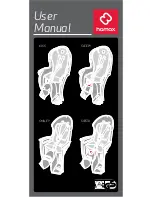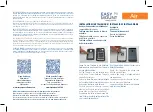
– 20 –
ICX418AKL
Notes on Handling
1) Static charge prevention
CCD image sensors are easily damaged by static discharge. Before handling be sure to take the following
protective measures.
a) Either handle bare handed or use non-chargeable gloves, clothes or material.
Also use conductive shoes.
b) When handling directly use an earth band.
c) Install a conductive mat on the floor or working table to prevent the generation of static electricity.
d) Ionized air is recommended for discharge when handling CCD image sensor.
e) For the shipment of mounted substrates, use boxes treated for the prevention of static charges.
2) Soldering
a) Make sure the package temperature does not exceed 80°C.
b) Solder dipping in a mounting furnace causes damage to the glass and other defects. Use a ground 30W
soldering iron and solder each pin in less than 2 seconds. For repairs and remount, cool sufficiently.
c) To dismount an image sensor, do not use a solder suction equipment. When using an electric desoldering
tool, use a thermal controller of the zero cross On/Off type and connect it to ground.
3) Dust and dirt protection
Image sensors are packed and delivered by taking care of protecting its glass plates from harmful dust and
dirt. Clean glass plates with the following operation as required, and use them.
a) Perform all assembly operations in a clean room (class 1000 or less).
b) Do not either touch glass plates by hand or have any object come in contact with glass surfaces. Should
dirt stick to a glass surface, blow it off with an air blower. (For dirt stuck through static electricity ionized
air is recommended.)
c) Clean with a cotton bud and ethyl alcohol if the grease stained. Be careful not to scratch the glass.
d) Keep in a case to protect from dust and dirt. To prevent dew condensation, preheat or precool when
moving to a room with great temperature differences.
e) When a protective tape is applied before shipping, just before use remove the tape applied for
electrostatic protection. Do not reuse the tape.
4) Installing (attaching)
a) Remain within the following limits when applying a static load to the package. Do not apply any load more
than 0.7mm inside the outer perimeter of the glass portion, and do not apply any load or impact to limited
portions. (This may cause cracks in the package.)
b) If a load is applied to the entire surface by a hard component, bending stress may be generated and the
package may fracture, etc., depending on the flatness of the ceramic portions. Therefore, for installation,
use either an elastic load, such as a spring plate, or an adhesive.
39N
Lower ceramic
Upper ceramic
Compressive strength
Low melting
point glass
29N
Shearing strength
29N
Tensile strength
0.9Nm
Torsional strength



































